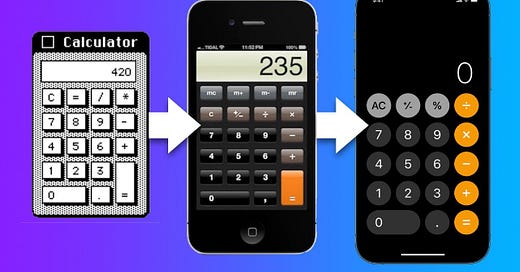GM Readers!
Today we cover Skeuomorphic Design. The design concept where if we make the new thing look like the old thing, it’s easier for users to try the new thing. But the risk of being “too skeuomorphic” is that we think the new thing is just a better version of the old thing.
Let’s dive right in!
-LJW
SHAMELESS Ask:
🙏 Share Life in Color with a friend and ask them to subscribe
🙏 Share on Twitter / Linkedin with a short note
🙏 Share on your company Slack / Teams channels and communities
One of the biggest topics surrounding emerging technology is adoption.
Once the emerging technology is good enough (aka it works!) to put out into the world, adoption ends up being a game about design.
Design sits at the intersection of product and distribution.
Good design super charges adoption. Good design also makes garnering attention easier.
To promote adoption, the initial use cases for emerging technology often look a lot like their predecessor technologies.
This is known as skeuomorphic design.
Skeuomorphic Design
Skeuomorphism is a design philosophy that imitates the form and appearance of real-world objects, creating a sense of familiarity and comfort for users. The new thing retains elements of the old thing it’s trying to replace.
By providing users with recognizable elements while introducing them to new concepts and technologies, skeuomorphism serves as a bridge between the old and the new — pushing us to adopt and use emerging technology.
Skeuomorphic design has become part of the modern playbook for launching technology.
Skeuomorphic design is everywhere.
Smartphone Interface: Early iterations of both Apple's iOS and Google's Android operating systems utilized skeuomorphic elements to help users transition from traditional phones to touch-based smartphones.
The calculator app looks like an actual calculator.

The Notes App looks like an actual notebook.

The read / newsstand app looks like an actual bookshelf.

Skeuomorphic design gives users recognizable elements to latch onto and makes its easier to try the new thing.
Skeuomorphic Design Beyond Visuals
Design is more than the visual elements.
Even the obvious design elements like UI (User Interface) and UX (User Experience) span beyond just visual design.
More broadly, the systems, processes, mechanisms and largely “how things actually work” behind a product and/or technology are also critical parts of design.
Some examples of non-visual skeuomorphic design in emerging technology:
ChatGPT: Let’s use AI to make writing and content creation easier.
NFTs: Let’s use blockchain to represent ourselves as profile pictures on social media.
Metaverse: Let’s use metaverse technology to host more lively meetings.
All of the above use cases are skeuomorphic because they are taking something we are already familiar with and just translating it onto the emerging technology.
This is great for initial adoption.
Easy to understand use cases bring in early users. Early adoption brings in more builders to build products for a growing user base which ideally drives more adoption for the emerging technology.
Skeuomorphic design is an important principle, but focusing on it too much can stall innovation.
Emerging technologies that hit that first stage of adoption through skeuomorphic might get stuck in skeuomorphic thinking.
Confusing the Appetizer for the Entree
By closely adhering to real-world counterparts, builders may miss opportunities to create more unique solutions that break free from traditional paradigms.
Every piece of foundational technology was once emerging and goes through this cold start problem.
Think steam engine, Internet, mobile phone, and now AI and Web3.
All of these technologies went through their own version of a skeuomorphic use case, but they also eventually broke out of the skeuomorphic design phase because the underlying technology enabled much more than the initial skeuomorphic use cases.
When Mobile first came out, if we just stayed with skeuomorphic design principles, we would have left it at “mobile phones are just phones in our pockets…” but of course it became much more than that … it became a new computing paradigm.
The mobile phone actually turned out to be a computing interface that impacted all sectors of the economy. (i.e. It went from can we put notes on our phone to we can put productivity and much more on our phone.)
For Web3 and AI, there is a risk that builders get stuck in the skeuomorphic phase… but these technologies are much more than that.
ChatGPT and AI changes the work paradigm, we go from being valued for the “how” to being valued for the “what and why” … it’s more than just making us better writers.
NFTs enable a digital ownership paradigm with infinite segmentation and programmability … it’s more than just PFPs for social media.
Metaverse technology enables bottoms up digital economies backed by digital property rights … its more than just having 3D meetings with avatars.
Whatever skeuomorphic use cases we have today with Web3 and AI is good for the initial adoption, but that just the tip of the iceberg.
The first movers in an emerging technology sector set the tone for what the emerging technology can do.
But the true innovators change our way of being.
We have to get beyond skeuomorphism, otherwise we’ll go from being innovators to renovators.
For AI and Web3, they are new computing paradigms … what that enables is yet to be seen.
But experimentation gets us there.
Keep cookin!



